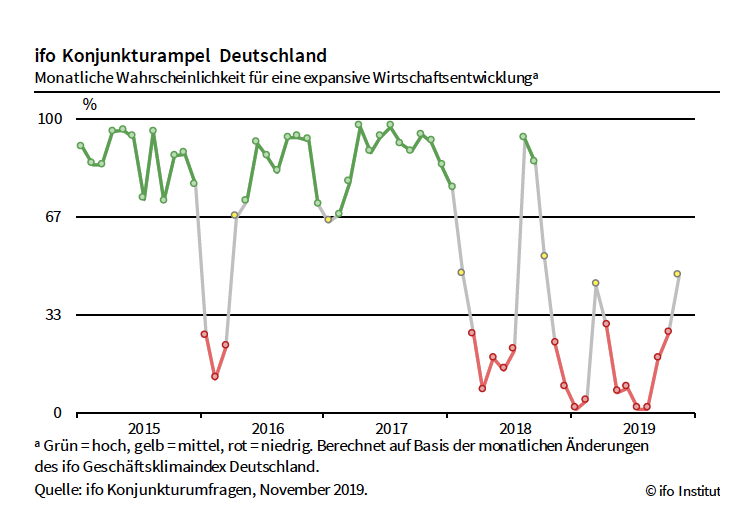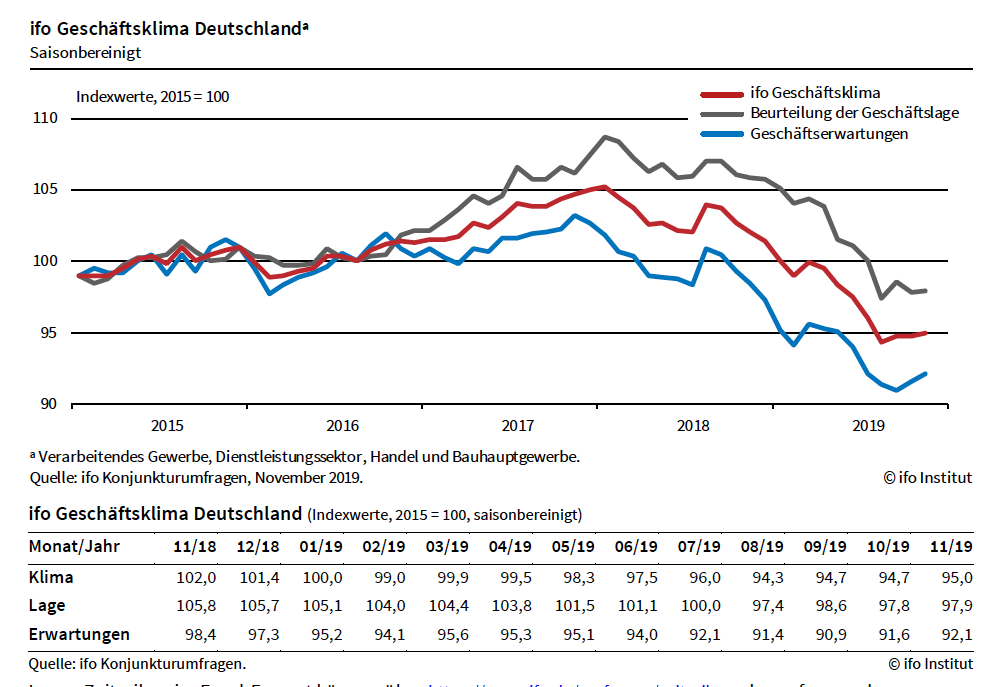Buy-signal ante portas.
Dear Readers,
 The ifo business climate improved slightly in November. Of particular interest was the development of business expectations for the economy as a whole and for industry as a whole, which we regard as a sentiment indicator for the global economy and the stock markets. The expectation component of the overall economy has now risen for the second time in succession. In the manufacturing sector, however, it stagnated after an increase in October. The ifo traffic light has thus changed from red to yellow (graphics).
The ifo business climate improved slightly in November. Of particular interest was the development of business expectations for the economy as a whole and for industry as a whole, which we regard as a sentiment indicator for the global economy and the stock markets. The expectation component of the overall economy has now risen for the second time in succession. In the manufacturing sector, however, it stagnated after an increase in October. The ifo traffic light has thus changed from red to yellow (graphics).
That's exciting. Every month, researchers at the Munich-based ifo Institute ask 10000 entrepreneurs about their business expectations for the coming half year. If expectations went up three times in a row after a previous decline, this (almost) always established a new trend. In the past, the major turning points in the economy could thus be predicted quite well. After all, those at the helm know best where the wind blows from.
 Should business expectations improve again in December, this would be an indication that the economic downturn that began in February 2018 is coming to an end - just as recession fears and crash risks are being reported everywhere.
Should business expectations improve again in December, this would be an indication that the economic downturn that began in February 2018 is coming to an end - just as recession fears and crash risks are being reported everywhere.
As you know, the seismograph distinguishes between three phases: "green" (quiet market = buy), "yellow" (turbulent market with positive expectation = invest, but with hedging) and "red" (turbulent market with negative expectation = do not invest).
In the last two months, the sum of the "good" probabilities remained well above 60 percent. Since the beginning of September, the seismograph has therefore been proposing to position itself at the upper end of the range defined by the private-wealth stock market indicator.
Currently, the probability of a calm, positive stock market is 46 percent. The probability of a turbulent, volatile market with a positive trend ("yellow") holds at 37 percent. The probability of negative turbulence is now only 17 percent. "Our input variables continue to signal calmness. Since the sum of the good probabilities has now even risen above 80 percent, the seismograph continues to suggest a maximum weighting of the equity quota," explains Oliver Schlick.
Conclusion:
The private-wealth stock market indicator had been out of the stock market since the end of February 2018. The rise in business expectations now gives reason to hope for a trend reversal in the economy and in cyclical stocks. The time has not yet come. But if the ifo expectation components rise again in December, the private-wealth stock market indicator would raise the equity quota to 30 - 70 percent of the individually planned equity component. If the capital market seismograph is then still positive, this would
mean a stock weighting in the upper range of the range.
yours
Klaus Meitinger
Note: Despite careful selection of sources, no liability can be accepted for the accuracy of the content. The information provided in private wealth is for information purposes only and does not constitute an invitation to buy or sell securities.